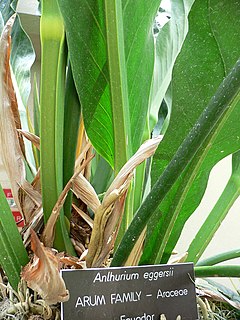
Aiphanes is a genus of spiny palms which is native to tropical regions of South and Central America and the Caribbean. There are about 26 species in the genus, ranging in size from understorey shrubs with subterranean stems to subcanopy trees as tall as 20 metres (66 ft). Most have pinnately compound leaves ; one species has entire leaves. Stems, leaves and sometimes even the fruit are covered with spines. Plants flower repeatedly over the course of their lifespan and have separate male and female flowers, although these are borne together on the same inflorescence. Although records of pollinators are limited, most species appear to be pollinated by insects. The fruit are eaten by several birds and mammals, including at least two species of amazon parrots.

Baccharis is a genus of perennials and shrubs in the aster family (Asteraceae). They are commonly known as baccharises but sometimes referred to as "brooms", because many members have small thin leaves resembling the true brooms. They are not at all related to these however, but belong to an entirely different lineage of eudicots. B. halimifolia is commonly known as "groundsel bush", however true groundsels are found in the genus Senecio.
Erythrina eggersii is a vine or tree in the family Fabaceae which is commonly known as cock's-spur, espuelo de gallo, or pinon espinoso. It is native to Puerto Rico, the British Virgin Islands and the U.S. Virgin Islands, where it is threatened by the act of habitat loss.

Baccharis arbutifolia is a species of flowering plant in the family Asteraceae found only in Ecuador. Its natural habitats are subtropical or tropical moist montane forests and subtropical or tropical high-altitude shrubland.
Baccharis aretioides is a species of flowering plant in the family Asteraceae that is endemic to Ecuador. Its natural habitat is subtropical or tropical high-altitude grassland. It is threatened by habitat loss.
Baccharis fusca is a species of flowering plant in the family Asteraceae that is endemic to Ecuador. Its natural habitat is subtropical or tropical moist montane forests. It is threatened by habitat destruction.
Baccharis hambatensis is a species of flowering plant in the family Asteraceae that is endemic to Ecuador. Its natural habitats are subtropical or tropical moist montane forests and subtropical or tropical high-altitude shrubland. It is threatened by habitat loss.
Baccharis hieronymi is a species of flowering plant in the family Asteraceae. It is found only in Ecuador. It grows in subtropical or tropical moist montane forests and subtropical or tropical high-altitude shrubland. It is threatened by habitat loss.
Baccharis huairacajensis is a species of flowering plant in the family Asteraceae. It is endemic to Ecuador. Its natural habitat is subtropical or tropical moist montane forests. It is threatened by habitat loss.
Baccharis klattii is a species of flowering plant in the family Asteraceae that is endemic to Ecuador. Its natural habitats are subtropical or tropical moist montane forests and subtropical or tropical high-altitude shrubland. It is threatened by habitat loss.
Critonia eggersii is a species of flowering plant in the family Asteraceae. It is found in Ecuador. Its natural habitat is subtropical or tropical moist lowland forests. It is threatened by habitat loss.
Lycoseris eggersii is a species of flowering plant in the family Asteraceae. It is found only in Ecuador. Its natural habitats are subtropical or tropical moist lowland forests and subtropical or tropical moist montane forests. It is threatened by habitat loss.
Acalypha eggersii is a species of plant in the family Euphorbiaceae. It is endemic to Ecuador. Its natural habitat is subtropical or tropical dry forests.

Anthurium eggersii is a species of plant in the family Araceae. It is endemic to Ecuador. Its natural habitat is subtropical or tropical moist lowland forests. It is threatened by habitat loss.
Maytenus eggersii is a species of plant in the family Celastraceae. It is a tree endemic to Ecuador. It is threatened by habitat loss.
Passiflora eggersii is a species of plant in the family Passifloraceae. It is endemic to Ecuador.
Psilanthele is a genus of plants in the family Acanthaceae, subfamily Acanthoideae, tribe Justicieae. The genus contains only one species, Psilanthele eggersii, native to Ecuador. Its habitat is coastal forest up to an elevation of 530 m. It assessed in 2003 as "critically endangered".
Siparuna eggersii is a scrambling, large shrub in the Siparunaceae family. It is endemic to Ecuador, where it is endangered due to habitat destruction. It has glabrous leaves and fig-like, red fruit with a lemon scent.
Stigmaphyllon eggersii is a species of plant in the Malpighiaceae family. It is a vine endemic to Ecuador. Its natural habitat is subtropical or tropical dry forests.
Xanthosoma eggersii is a species of plant in the family Araceae. It is endemic to Ecuador. Its natural habitat is subtropical or tropical moist lowland forests. It is threatened by habitat loss.




